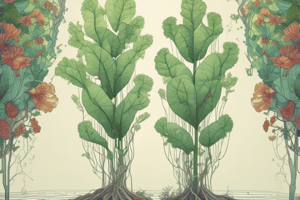Podcast
Questions and Answers
How do root hairs increase the absorption of water and minerals from the soil?
How do root hairs increase the absorption of water and minerals from the soil?
- By releasing excess water back into the soil
- By decreasing the surface area available for absorption
- By conducting photosynthesis
- By increasing the surface area available for absorption (correct)
In the process of osmosis in root hairs, water molecules move from __________.
In the process of osmosis in root hairs, water molecules move from __________.
- the xylem to the phloem
- inside the root to the soil
- an area of higher water concentration to an area of lower water concentration (correct)
- an area of lower water concentration to an area of higher water concentration
How are mineral salts absorbed by plant cells from the soil?
How are mineral salts absorbed by plant cells from the soil?
- Through photosynthesis
- Through transpiration
- Passively by diffusion
- Actively by moving against their concentration gradient (correct)
Which structure in the root prevents water movement along the apoplast pathway?
Which structure in the root prevents water movement along the apoplast pathway?
How does water move through the symplast pathway in roots?
How does water move through the symplast pathway in roots?
Which pathway involves water moving along cell walls and intercellular spaces without crossing cell membranes?
Which pathway involves water moving along cell walls and intercellular spaces without crossing cell membranes?
Active transport of minerals involves moving them __________ their concentration gradient.
Active transport of minerals involves moving them __________ their concentration gradient.
What is the role of root hairs in the uptake of water and minerals from the soil?
What is the role of root hairs in the uptake of water and minerals from the soil?
What is the role of the Casparian strip at the endodermis?
What is the role of the Casparian strip at the endodermis?
What is translocation in plants?
What is translocation in plants?
How does root pressure contribute to water movement in plants?
How does root pressure contribute to water movement in plants?
What is the primary force driving capillarity in plant physiology?
What is the primary force driving capillarity in plant physiology?
How does sugar transport occur in plants?
How does sugar transport occur in plants?
What causes water to move into sieve tubes of phloem in plants?
What causes water to move into sieve tubes of phloem in plants?
What investigation helps understand how adhesion and cohesion contribute to water movement against gravity?
What investigation helps understand how adhesion and cohesion contribute to water movement against gravity?
'Translocation' is essential for which aspect of plant physiology?
'Translocation' is essential for which aspect of plant physiology?
What practical investigation is used to observe the rise of water in capillary tubes due to root pressure?
What practical investigation is used to observe the rise of water in capillary tubes due to root pressure?
What is the primary function of sugar transport in plants?
What is the primary function of sugar transport in plants?
Which pathway for water movement involves crossing cell membranes?
Which pathway for water movement involves crossing cell membranes?
What process primarily facilitates the absorption of water through root hairs?
What process primarily facilitates the absorption of water through root hairs?
Which structure in the root prevents water movement along the apoplast pathway?
Which structure in the root prevents water movement along the apoplast pathway?
How are mineral salts absorbed by plant cells from the soil?
How are mineral salts absorbed by plant cells from the soil?
What happens to water molecules during the process of osmosis in root hairs?
What happens to water molecules during the process of osmosis in root hairs?
Which pathway involves water moving along cell walls and intercellular spaces without crossing cell membranes?
Which pathway involves water moving along cell walls and intercellular spaces without crossing cell membranes?
What is the role of root hairs in the uptake of water and minerals from the soil?
What is the role of root hairs in the uptake of water and minerals from the soil?
What is the primary function of sugar transport in plants?
What is the primary function of sugar transport in plants?
What investigation helps understand how adhesion and cohesion contribute to water movement against gravity?
What investigation helps understand how adhesion and cohesion contribute to water movement against gravity?
In which pathway for water movement do cells interconnect through plasmodesmata?
In which pathway for water movement do cells interconnect through plasmodesmata?
Which of the following best describes the role of the Casparian strip in plant physiology?
Which of the following best describes the role of the Casparian strip in plant physiology?
What is the primary force driving capillarity in plant physiology?
What is the primary force driving capillarity in plant physiology?
How does sugar transport occur in plants?
How does sugar transport occur in plants?
What is the primary function of sugar transport in plants?
What is the primary function of sugar transport in plants?
Which of the following does not contribute to water movement in plants?
Which of the following does not contribute to water movement in plants?
What causes water to move into sieve tubes of phloem in plants?
What causes water to move into sieve tubes of phloem in plants?
What is translocation in plants?
What is translocation in plants?
Which of the following is not a mechanism of movement in translocation?
Which of the following is not a mechanism of movement in translocation?
Which of the following is not a practical investigation related to fluid dynamics in plants?
Which of the following is not a practical investigation related to fluid dynamics in plants?
What is the role of cohesion and adhesion in plant physiology?
What is the role of cohesion and adhesion in plant physiology?
What mechanism allows plants to absorb mineral salts against their concentration gradient?
What mechanism allows plants to absorb mineral salts against their concentration gradient?
What mechanism is responsible for the active loading of sucrose into the sieve tubes of the phloem in leaves?
What mechanism is responsible for the active loading of sucrose into the sieve tubes of the phloem in leaves?
Which pathway does water follow after reaching the Casparian strip in the endodermis?
Which pathway does water follow after reaching the Casparian strip in the endodermis?
What type of transport is responsible for water movement along the symplast pathway through plasmodesmata?
What type of transport is responsible for water movement along the symplast pathway through plasmodesmata?
Which force contributes to the movement of water and minerals from the roots to the leaves through the xylem?
Which force contributes to the movement of water and minerals from the roots to the leaves through the xylem?
Which statement best describes the function of the Casparian strip in plant physiology?
Which statement best describes the function of the Casparian strip in plant physiology?
Which pathway plays a crucial role in allowing water to reach the Casparian strip in the endodermis?
Which pathway plays a crucial role in allowing water to reach the Casparian strip in the endodermis?
What is the primary force driving water movement in the symplast pathway?
What is the primary force driving water movement in the symplast pathway?
Which mechanism of solute transport in plants is driven by the concentration gradient?
Which mechanism of solute transport in plants is driven by the concentration gradient?
Which process primarily facilitates the absorption of water through root hairs?
Which process primarily facilitates the absorption of water through root hairs?
Which investigation is used to quantify the rate of transpiration under various environmental conditions?
Which investigation is used to quantify the rate of transpiration under various environmental conditions?
What causes water to move from the soil into the root hairs during the process of osmosis?
What causes water to move from the soil into the root hairs during the process of osmosis?
What is the role of cohesion and adhesion in the process of capillarity?
What is the role of cohesion and adhesion in the process of capillarity?
Which statement best describes the process of translocation?
Which statement best describes the process of translocation?
How does the Casparian strip affect water movement in the root?
How does the Casparian strip affect water movement in the root?
What is the primary function of sugar transport in plants?
What is the primary function of sugar transport in plants?
Which pathway for water movement involves crossing cell membranes and moving through the cytoplasm?
Which pathway for water movement involves crossing cell membranes and moving through the cytoplasm?
How does active transport enable plants to absorb mineral salts from the soil?
How does active transport enable plants to absorb mineral salts from the soil?
What is the role of root pressure in the movement of water through the xylem?
What is the role of root pressure in the movement of water through the xylem?
Which statement best describes the function of the phloem in plant physiology?
Which statement best describes the function of the phloem in plant physiology?
Flashcards are hidden until you start studying




